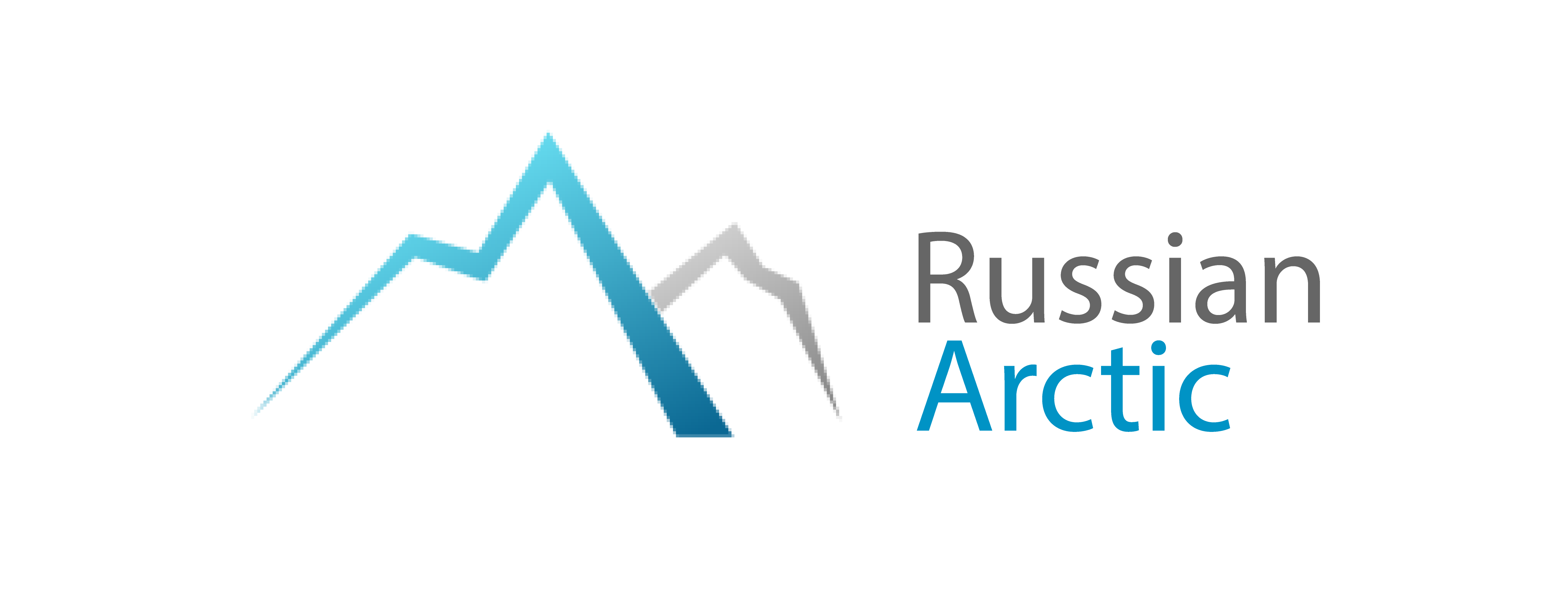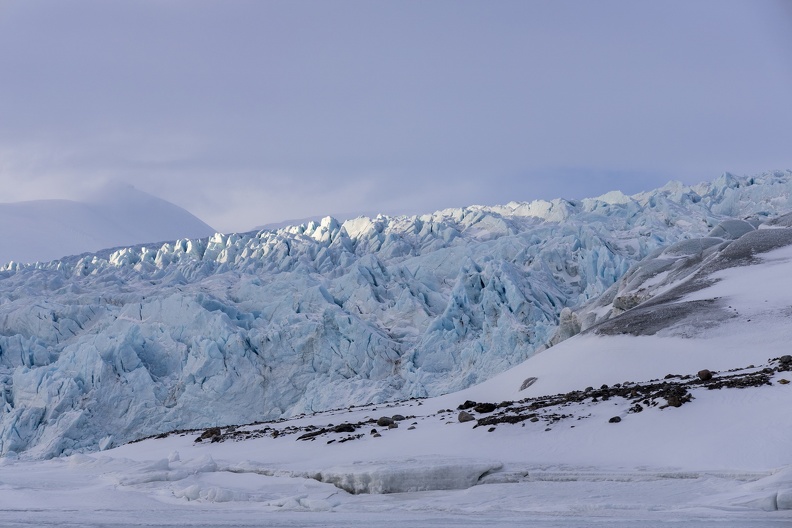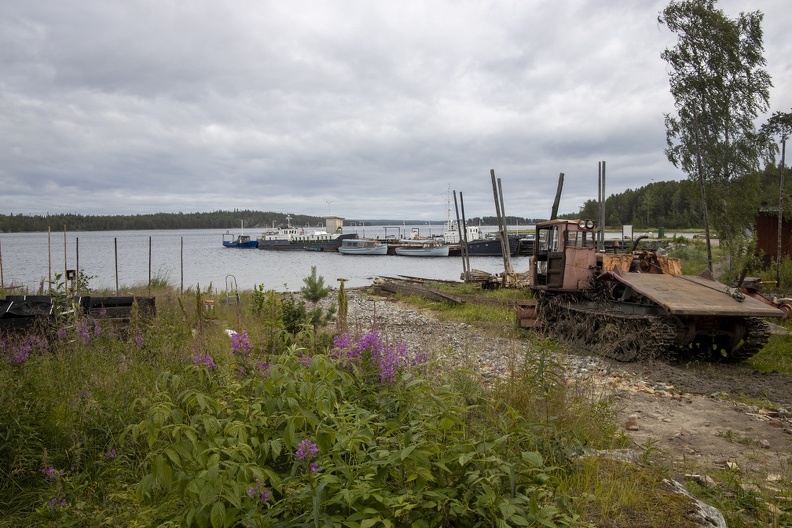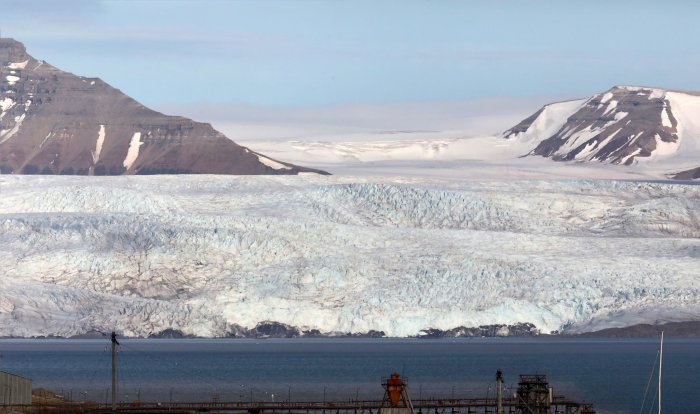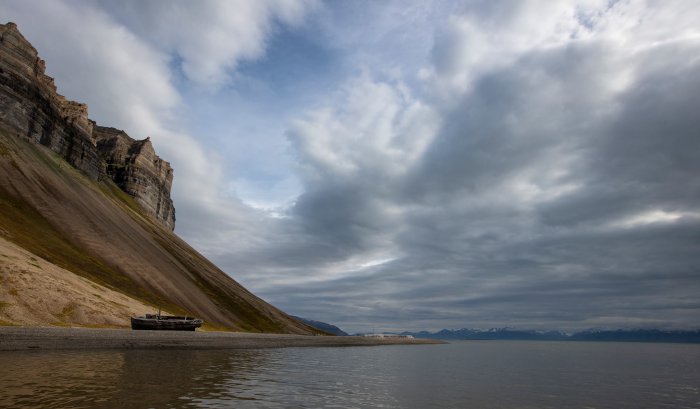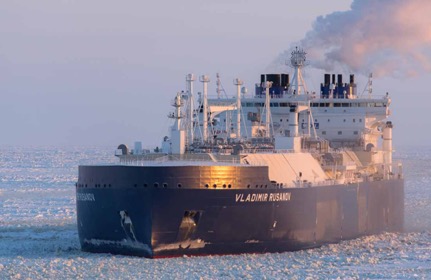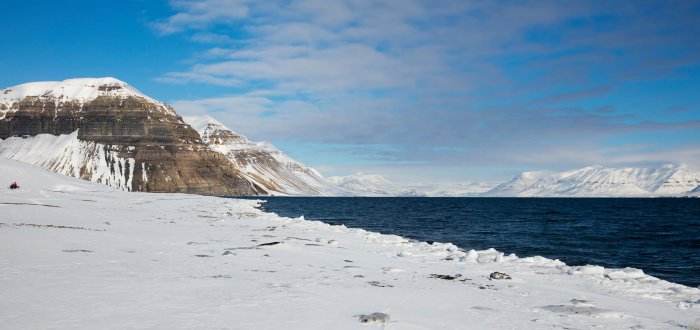Keywords: arctic shipbuilding, icebreaking cargo vessel, Northern Sea Route, ship design, ice class, liquefied natural gas
Modern Arctic cargo fleet of Russia
The desire of shipowners to minimize dependence on icebreaker services, as well as the development of new projects for the export of hydrocarbons from the Russian Arctic, have led to the creation of fundamentally new types of icebreaking cargo vessels capable of providing reliable, cost-effective and safe shipping. Such cargo vessels of new generation equipped with electric motor in azimuthing propeller pod units (Azipod of ABB) appeared in the Arctic after Norilsk Nickel mining company, in order to reduce the cost of transportation of production, decided in 2004 to create its own cargo fleet to replace SA-15 (“Norilsk” type) vessels, built in the 1980s. The design of the Arctic container ship with 648 TEU capacity, intended to ensure year-round transportation of Norilsk Nickel cargo on the Arctic line Murmansk-Dudinka, was developed by Kvaerner Masa-Yards research center (currently Aker Arctic Technology) in accordance with the Double Acting Ship (DAS™) concept for the conditions of independent ice navigation in the south-western part of the Kara Sea.
The first prototype diesel-electric arctic container vessel Norilskiy Nickel (see principal parameters in Table 1) was built at the Helsinki shipyard and successfully passed delivery ice trials in the Spring of 2006 [1]. Then another 4 sister ships of this type were built at the Nordic Yards, and by the same shipyard – Arctic product tanker Yenisei, also according to Norilskiy Nickel design concept, with the same dimensions, hull form and propulsion system. Almost at the same time, 3 Arctic shuttle tankers of Vasily Dinkov type were built by Samsung Heavy Industries shipyard for the purpose of exporting crude oil from the Varandey offshore ice-resistant terminal, and for exporting of oil produced by the offshore ice-resistant stationary platform Prirazlomnaya, two shuttle tankers of Mikhail Ulyanov type were delivered from Admiralty Shipyards in St. Petersburg. The main characteristics of both types of tankers, which have some differences due to different design approaches but the same ice class and deadweight, are given in Table 1. Aker Arctic Technology carried out model tests in the own ice tank and designed hull form of these vessels, as well as developed a technical design of Mikhail Ulyanov type tankers [2].
Table 1 - Main characteristics of icebreaking cargo vessels for Russian Arctic, built in the 21st century
|
Name of the first vessel in series |
NorilskiyNickel(Enisey) |
VasiliyDinkov |
MikhailUlyanov |
Christophe de Margerie |
Shturman Albanov |
B.Sokolov(Y.Kuchiev) |
Audax |
|
Number of vessels in series |
5 + 1 |
3 |
2 |
15 |
7 |
1 + 1 |
2 |
|
Years of delivery |
2006-09, 2011 |
2008-09 |
2010 |
2016-2019 |
2016-17, 2019 |
2018-19 |
2016 |
|
Country of build |
Finland, Germany |
S.Korea |
Russia |
S.Korea |
S.Korea |
China, Finland |
China |
|
Ice class |
Arc7 |
Arc6 |
Arc6 |
Arc7 |
Arc7 |
Arc7 |
Arc7/PC3 |
|
Length overall, m |
169 |
257.3 |
257.7 |
299 |
245 |
214 (229) |
206.3 |
|
Breadth, m |
23.1 |
34 |
34 |
50 |
34 |
34 (32.5) |
43 |
|
Design draft, m |
9.0 |
14.0 |
14.0 |
11.7 |
9.0 |
11.7 |
7.5 |
|
Deadweight, ton |
14500 |
70000 |
70000 |
80000 |
38000 |
43400 |
24500 |
|
Propulsion |
1 Azipod |
2 Azipod |
2 Azipod |
3 Azipod |
2 Azipod |
2 Azipod |
2 CPP |
|
Shaft power, MW |
13 |
20 |
17 |
45 |
22 |
22 |
24 |
|
Icebreaking capability, m (ahead / astern) |
1.5 / 1.65 |
1.7 / 1.7 |
1.0 / 1.6 |
1.5 / 2.1 |
1.4 / 1.7 |
1.5 / 1.8 |
1.5 |
The next big and important step in the development of Arctic cargo vessels was the realization of projects for the export of hydrocarbons from the Gulf of Ob. First of all, this is Yamal LNG project, which envisages the construction of a natural gas liquefaction plant in Sabetta and seaborn transportation of LNG and gas condensate to European and Asian markets. With the most active participation of Aker Arctic, a design concept of the Arc7 ice class LNG carrier with a capacity of about 170 000 m3 was created. Concept was based on propulsion complex of three Azipod units with a total power of 45 MW, providing independent sailing in ice conditions, both ahead and astern, and moderate icebreaking bow hull lines are also designed for acceptable seaworthiness in open water [3]. The first arctic icebreaking LNG carrier, Christophe de Margerie, successfully passed ice trials and was commissioned in 2016; the Korean DSME shipyard is currently completing the construction of this ship series (known as the Yamalmax type) of 15 LNG carriers.
Specially for the year-round delivery of large size modules for the construction of a gas liquefaction plant in Sabetta, Aker Arctic also designed two unique cargo vessels, built by the GSI shipyard in Guandzhou (China) in the shortest possible time (about 2 years from the date of signing of shipbuilding contract to delivery, including design) – arctic module carriers Audax and Pugnax, having a diesel-electric propulsion with two shaft lines from electric motors to fixed-pitch propellers. In the process of designing these ships, a number of original solutions were applied, including the optimization of very sophisticated ballast system, wide cargo deck with a special heating system, etc. Year-round operation of these vessels in 2016-2018 with the use of escort by nuclear icebreakers in Kara Sea, contributed significantly to the successful completion of the construction and early commissioning of all trains of Yamal LNG plant.
For the export of gas condensate from Sabetta, the Greek shipowner Dynacom under the charter agreement with Yamal LNG ordered two specialized tankers of the Arc7 class. One of them is the Boris Sokolov tanker, built according to the original Aker ARC212 design by Guangzhou shipyard, commissioned in December 2018 and is already successfully exporting gas condensate to Europe. The second vessel, which has a slightly shorter beam (based on the limitations of the construction drydock) and an increased length to ensure the same cargo capacity, was designed and built by Arctech shipyard in Helsinki and commissioned in August 2019. At the beginning of May 2019, Aker Arctic specialists conducted field ice trials of tanker Boris Sokolov, which confirmed the high ice performance of the vessel and the possibility of independent year-round navigation in the ice conditions of the south-western part of the Kara Sea.
Since May 2016, the new Arctic Gates single point terminal, installed by Gazpromneft company in the Gulf of Ob for the transshipment of oil from the Novoportovskoye field, has also been successfully operating. Specially for the export of oil from this terminal, a series of Arc7 ice class shuttle tankers of Shturman Albanov type was created with a maximum deadweight of about 40,000 tons based on a draft limitation at cape Kamenny of about 9 m. Due to an increase in export volumes in addition to six tankers successfully operating on the transportation of crude oil to the transshipment terminal in Murmansk in independent navigation mode, and in the fast ice of the Gulf of Ob – in the channel pre-laid by shallow-draft icebreakers, were ordered with the bottom of this type, which should be delivered in autumn 2019. Model testing and development of hull form of these vessels, to ensure their effective operation in extreme shallow water at maximum ice thickness in the Gulf of Ob, was also carried out in the Aker Arctic ice tank. The main characteristics of modern cargo vessels for the Russian Arctic, created in the 21st century, are given in Table 1.
An analysis of the experience of creating a modern Arctic cargo fleet shows that at the moment there are no technical obstacles for the design of cargo vessels of various types (dry cargo vessels, tankers, bulk carriers, LNG carriers, etc.) of high ice classes (up to Arc7) of practically any size necessary a specific logistic scheme capable for year-round transportation from the Ob-Yenisey area to the west. It should also be noted that this year the construction will be completed of current series of Arctic cargo vessels, which were developed and designed several years ago. It is already obvious that in 2020-21 no any new Arctic cargo vessel will be built. Nevertheless, the Government of the Russian Federation declares a further increase of transportation volumes along the Northern Sea Route (NSR) to 80 million tons (mainly related to new hydrocarbon export projects), which will require a corresponding increase in the cargo fleet. The most important trends for the further improvement of the Arctic cargo fleet on the basis of the current level of development of marine equipment and the main challenges for designers, which must be taken into account in order to make the new vessels as efficient and optimal as possible to ensure the planned volumes of cargo transportation by the NSR and at the same time to met the most recent national and international safety and environmental requirements when operating in the Arctic region, are given below.
Main trends of arctic shipping development
On the base of the experience gained when developing modern Arctic cargo vessels and the trends observed during the process of their design, the following main trends can be noted that affect the further development of the Arctic cargo fleet:
1) Use of Arctic cargo vessels with large capacity.
2) Development of year-round transportation along the whole NSR water area.
3) Use of transportation schemes with transshipment of cargo from Arctic shuttle vessels to vessels without ice class
4) Use of LNG as fuel on new cargo vessels (in addition to LNG carriers) and icebreakers.
For example, the cargo capacity of Christophe de Margerie type LNG carriers of 172,000 m3corresponds to the most common capacity of new conventional (open water) LNG carriers, which is a significant economic advantage, despite the need for large amount of dredging in the Gulf of Ob and associated operational difficulties, and also allowed organizing an efficient ship-to-ship transshipment of LNG near Norwegian Honningsvåg.
For new projects for the export of coal and oil from Arctic, bulk carriers and tankers of about 100-115 thousand tons of deadweight are currently being considered. The main restrictions are associated with the presence of minimal water depths along the existing recommended routes, and the situation is complicated by insufficient hydrographic survey of the Northern Sea Route water area. The results of calculating the transit depths on the recommended high-latitude NSR route north of the Novosibirsk Islands are given in [4]. Based on them, it can be concluded that the minimum transit depth on this route is 17 m, which accordingly limits the draft of vessels to a maximum of 16 m. According to the Administration of the Northern Sea Route, the maximum draft with which vessels ever transited along the NSR was 15.4 m (tanker “Propontis”, transit voyage in navigational season of 2013).
Difficult ice conditions force vessels to deviate from the recommended routes both when sailing independently and under icebreaker escort, while a significant difference from the recommended routes in shallow waters increases the risk of accidents associated with touching the ground. A typical description of such a situation is given in the AARI publication [5] on the results of voyages of Yamalmax LNG carriers from Sabetta along the eastern part of the Northern Sea Route in June-July 2018. Accordingly, in the case of organizing year-round navigation along the NSR, when such deviations can to be regular, in the current situation with the exploration of the NSR water area, there is a need for an additional risk assessment and a reasonable choice of the design draft of future vessels.
In addition, in case there is a sufficient traffic in the winter period along the Northern Sea Route, it becomes possible to use a permanent channel through an extensive zone of fast ice, covering the archipelago of the Novosibirsk Islands and the adjacent shallow water areas of the Laptev Sea and the East Siberian Sea, with a view to more stable passage of this area with fairly high speeds. In this case, vessels can use the route through the Sannikov Strait, which imposes a draft limit of 12 m [6].
A great influence on the substantiation of the main characteristics of Arctic cargo vessels, including their cargo capacity, hull form, power and type of propulsion system, has the choice of the optimal transportation scheme. For example, for projects for the export of crude oil from the shallow water areas of the Pechora Sea and the Gulf of Ob, according to the results of a comprehensive feasibility studies, the scheme using shuttle tankers for active ice navigation and the organization of oil transshipment in the Murmansk region was evidently more profitable [7]. However, similar studies of the most efficient logistic scheme for LNG export from the Gulf of Ob westbound showed the economic advantage of direct transportation by large LNG carriers to the ports of Western Europe [3]. The ship-to-ship transshipment of LNG organized at the end of 2018 from in the Honningsvåg area was associated with faster than planned commissioning of the LNG plant and exceeding the planned export volumes. However, in relation to the planned year-round LNG export from the Gulf of Ob eastbound to the countries of Southeast Asia, taking into account significantly different ice conditions and the ratio of the duration of navigation in ice and in open water, the option of organizing LNG transshipment in the Kamchatka region gets certain advantages.
Designing of the fleet for year-round navigation along the entire NSR water area
Thus, at present, new plans for extending the period for eastbound navigation along the NSR are becoming a priority challenge for designers. Now year-round navigation in the NSR is carried out only in the south-western part of the Kara Sea. Throughout the whole NSR water area, vessels navigate mainly from July to November. In recent years, the ice conditions in these months has been favorable enough for the organization of transit voyages and operations for the delivery of supply cargo. It should also be noted that the logistics scheme of the Yamal LNG project, currently used, involves the export by specially constructed icebreaking LNG carriers of Yamalmax type eastbound for the period no more than 6 months (from July to December). More difficult conditions of year-round navigation along the entire NSR area dictate the following main challenges in the design of new vessels:
-
Increased requirements for ice class and performance in ice.
-
Increased need for icebreaker support.
-
Optimization of joint operation of icebreakers and cargo fleet.
The positive factors at present include the fact that in the coming few years three universal nuclear-powered icebreakers of Arktika type with 60 MW power should enter the operation, also the design of nuclear icebreaker-leader with 120 MW power is underway. It is also planned to build four linear icebreakers with a capacity of 40-45 MW, which will operate on LNG fuel. The design concept of such icebreaker (Aker ARC123) was developed by Aker Arctic by order of FSUE Rosatomflot. According to the idea of Atomflot, these icebreakers with a draft of 9 m, and autonomy of operating on LNG of 30 days, will operate mainly in the water area of the Kara Sea, the Gulf of Ob and the Yenisey Gulf, carrying out bunkering by LNG at the terminal in Sabetta, which will allow more active use of nuclear icebreakers in the eastern part of NSR. At the same time, it is known that the operation of vessels with icebreaking assistance in more severe ice conditions compared to those in which it can be operated independently can lead to higher risks of damage to the hull. Also, there is a need to search for optimal methods of escorting and organization of convoys, which must be taken into account in the process of the designing of cargo vessels [8].
An example of the lack of sufficient experience of year-round navigation in the eastern region of the Russian Arctic is the voyage of tanker Boris Sokolov and LNG carrier Boris Davydov from Asia via the Northern Sea Route to Sabetta at the end of December 2018 - January 2019. Initially, it was planned to independently transit of tanker Boris Sokolov on the general background of rather favorable ice conditions, which corresponded well to the level of ice performance of the tanker. However, at the very beginning of ice route in the Bering and Chukchi Seas, operators encountered a number of adverse ice phenomena that were not usual for traditional areas of the western part of the NSR, which significantly slowed down the progress of the vessel. Given the limited supply of the bunker on the tanker, it was decided to wait for the approach of LNG carrier Boris Davydov, whose power plant uses LNG transported in cargo tanks, and which has significantly greater ice performance in astern mode, and after further successful NSR transit of both ships in convoy Boris Sokolov arrived to Sabetta on 20.01.2019.
The planned for the near future organization of LNG export from the Gulf of Ob to the east in year-round mode requires special studies, creation of new generation of icebreaking shuttle LNG carriers, and powerful linear icebreakers. In particular, this means that, for example, new arctic LNG carriers to be build for the Arctic LNG 2 project should differ in design concept from Christophe de Margerie type LNG carriers. Aker Arctic is already carrying out appropriate design studies in this direction, developing optimized solutions for the main dimensions, the shape of bow and the propulsion system.
According to the results of previous studies, the cost of transportation of hydrocarbons from developing projects in Russian Arctic to Asia is significantly higher than to Europe. As shown by technical and economic calculations, the average annual cost of LNG delivery from Yamal to the Asian market in the case of organizing such year-round transportation will be 3-4 times higher compared to year-round transportation to Europe [9]. Estimates of the feasibility of exporting crude oil from the Khatanga region by Aframax class tankers have shown that even for such location of the export terminal, the cost of delivering oil to consumers in Southeast Asia will be 1.5 times higher compared to shipping to ports in Western Europe [10].
The main obstacle to the development of transit transportation of containerized cargo along the Northern Sea Route is the need to ensure a constant schedule of cargo delivery all-year-round. Earlier, Aker Arctic completed a design study of an Arctic container ship with a capacity of 5000 TEU. The creation of a specialized Arctic container ship with increased container capacity will maximize the potential of a future container line using shuttle transit transport of containers along the Northern Sea Route between hub ports.
Using LNG as a fuel on arctic cargo vessels
One of the most effective methods of reducing emissions into the atmosphere is the use of gas fuel on ships, which completely eliminates the emission of sulfur oxides and solid particles, reduces nitrogen oxide emissions by 90% and 30%, and reduces CO2 emissions. This is evidenced by the rapid increase in the number of ships of the worldwide fleet using LNG as fuel. The possibility of a total ban on the use of heavy fuel in the Arctic is also under discussion.
Aker Arctic, having advanced experience in the design of LNG-fuelled icebreakers, has also carried out a number of studies using LNG on cargo vessels that have shown that there are no technical obstacles to this opportunity. The use of diesel electric power plants, which is a standard solution, with dual-fuel medium-speed diesel engines on ships of high ice classes allows avoiding sharp fluctuations of engine load. On tankers and bulk carriers, LNG fuel tanks can be installed on an open deck, which does not entail the use of additional space; on container ships, LNG tanks can be placed only in the ship's hull, due to which their container capacity is slightly reduced.
The possibility of using LNG as fuel on Arctic vessels is limited by the lack of a bunkering system in the Arctic region. One of the possible design and logistics solutions may be the creation and placement along the Northern Sea Route of several floating LNG storages, which can be used both for supplying gas to Arctic settlements and for bunkering cargo vessels following the NSR routes [11]. As a first step, one can consider the intention of Novatek to create a transshipment point with a capacity of 20 million tons on Kamchatka Peninsula by 2023, and investigate the possibility of LNG bunkering of future shuttle container ships at this terminal.
Changes in ice classification of Russian Maritime Register of Shipping ang in the Rules for navigation on NSR
As new challenges for designers the recently introduced changes to the Rules for the classification and construction of ships of the Russian Maritime Register of Shipping (RS) should be mentioned. Following the basic ideology and approaches of the international Polar Code, the Register removed from the “Classification” section tables that contained information on permissible operating areas and ice navigation conditions, characteristics of ice conditions and corresponding operating modes for ships depending on thier ice classes. The new version of the Rules, available on the RS website [12], now contains only one table containing indicative descriptions of ice classes of the Register. According to the Register, the determination of the permissible ice class based on the specific ice conditions in the area of operation is the prerogative of the Harbour Master, the Administration of the Northern Sea Route or the ship operator, and the choice of the ice class of the designed ship should also be justified by its owner or designer.
It should be noted that in general these changes are aimed at providing more opportunities for designers and operators to make an informed choice of the most suitable level of both ice hull reinforcements, parameters of propulsion system and other characteristics of the vessel, based on an adequate assessment of all risks, as applied to the estimated areas of ship operation. At the same time, it is important to maintain a correct understanding of how designed ships will meet operating conditions. It should be noted that, at a glance at the new table, it seems that the Register has tightened requirements for its own Arctic ice classes (for example, the description of the Arc7 ice class indicates navigation during winter-spring navigation in level first-year ice up to 1.4 m thick, but the icebreaking capability of modern vessels of this class is much higher and reaches 2.1 m - see table 1). In addition, the regime of icebreaking assistance has now generally been moved beyond the classification and is entirely at the discretion of the shipowner and designer. In this case, it is necessary that the Polar Ship Certificate issued by Classification Society in accordance with the requirements of the Polar Code should clearly indicate the actual operational limitations when operating in ice for a specific ship design.
This means that the ship designers will need to study the navigation rules even more carefully in those areas for which the polar class vessel is designed, that is, in our case, the “Rules for navigation in the water area of the Northern Sea Route”, which are also being prepared for changes. The draft of these changes has been submitted for discussion by all interested parties [13] and is currently being approved by the Russian Government. From the published materials it follows that it is supposed, in particular, to easy the requirements for the admission of vessels with ice classes Arc4 and Arc5 when operating under icebreaking assistance. These proposals are based on the experience gained from the operation of powerful nuclear icebreakers assisting relatively small vessels, in particular using close towing to the most severe ice conditions, which is unacceptable for large cargo vessels requiring special methods for escorting them by icebreakers.
Conclusion
The development of oil&gas projects in the Russian Arctic basin has led to the creation of principally new types of large Arctic cargo vessels for ice navigation, significantly surpassing traditional icebreaking transport vessels in their operational capabilities. Further increase in export volumes, new plans for organizing year-round eastward navigation along the Northern Sea Route, as well as new environmental requirements, pose designers new tasks and challenges in creating cargo vessels capable of providing reliable, cost-effective and safe shipping in the Arctic.
As the main conclusion, it can be noted that the selection of optimal parameters and the further design of future Arctic cargo vessels should be based on the results of a comprehensive feasibility study tailored for each specific shipping project, which shall cover the detailed assessment of ice and navigation conditions in the areas of operation, the estimated traffic volumes and the use of different possible transportation schemes, the availability and capabilities of icebreakers, and all the issues related to the features of operation of the designing vessel in ice.
References:
2. A. Iyerusalimskiy, P. Noble. Design Challenges for a Large Arctic Crude Oil Tanker //Proceedings of the 8th International Conference and Exhibition on Performance of Ships and Structures in Ice (ICETECH’08). Calgary, Canada, 2008, ISBN 978-0-9780896-1-0
3. Tsoy L.G., Andryushin A.V., Shtrek A.A. Obosnovaniye osnovnykh parametrov perspektivnykh krupnotonnazhnykh gazovozov dlya Arktiki [Substantiation of principal parameters of prospective large capacity LNG carriers for the Arctic] // Problems of the Arctic and Antarctic. No. 3 (97). SPb., AARI, 2013. pp. 46-56. (in Russian)
4. Afonin A.B., Olkhovik Ye.O., Tezikov A.L. Razrabotka metodov otsenki prokhodnykh glubin na trassakh Severnogo morskogo puti v zavisimosti ot podrobnosti syemki relyefa dna [Development of methods for assessing the depth of passage on the routes of the Northern Sea Route, depending on the details of the bottom topography survey] // Waterways of communication and hydrography. Bulletin of the State University of Maritime and River Fleet named after admiral S.O.Makarov. № 4 (32), 2015. p. 90-95. DOI: 10.21821 / 2309-5180-2016-8-4-62-68. (in Russian)
5. Makarov Ye.I., Brestkin S.V., Gavrilov YU.G., Lyamzin M.O., Folomeyev O.V. Pervoye bezledokol'noye plavaniye po trasse Severnogo morskogo puti tankerov tipa Yamalmax v period ranney letney navigatsii [The first icebreaker-free voyage along the Northern Sea Route of Yamalmax tankers during the early summer navigation period] (in Russian) URL: http://www.aari.ru/misc/publicat/sources/33/RPR-33el_l_37-39.pdf (access date 24.06.2019)
6. Shtrek A.A., Buyanov A.S. Tekhniko-ekonomicheskoye obosnovaniye optimal'nykh parametrov arkticheskogo konteynerovoza dlya tranzitnykh perevozok po Severnomu morskomu puti [Feasibility study of the optimal parameters of the Arctic container ship for transit traffic on the Northern Sea Route] (in Russian) // Scientific and technical bulletin of the Russian Maritime Register of Shipping, No. 42/43, 2016. P.23-30. (in Russian)
7. Shtrek A. A. Obosnovaniye osnovnykh kharakteristik chelnochnykh tankerov dlya vyvoza nefti iz arkticheskikh rayonov[Justification of the main characteristics of shuttle tankers for the export of oil from the Arctic regions] // Perspective types of vessels for the Arctic. Transactions of CNIIMF. SPb, 2003. P. 94-100. (in Russian)
8. Shtrek A.A. Vybor optimalnogo stsenariya ekspluatatsii pri proyektirovanii krupnotonnazhnykh arkticheskikh transportnykh sudov [Selection of the optimal operating scenario for the design of large-capacity arctic transport vessels] // Proceedings of the all-Russian scientific-practical conference dedicated to the 100th anniversary of the birth of R.Ye. Alekseev. NSTU, Nizhny Novgorod, November 23-24, 2016 P.165-173. (in Russian)
9. Tsoy L.G., Andryushin A.V., Shtrek A.A., Sherstnova I.V. Issledovaniye optimalnykh kharakteristik perspektivnogo arkticheskogo gazovoza dlya vyvoza SPG iz p.Sabetta [Investigation of optimal characteristics of perspective LNG carrier for Sabetta] //Technical operation of marine fleet. Transactions of CNIIMF. St. Petersburg, 2012. P.3-15. (in Russian)
10. Shtrek A. Otsenka vozmozhnosti vyvoza nefti iz rayona Khatangi po SMP tankerami klassa Aframax [Assessment of the possibility of exporting oil from the Khatanga area via NSR using Aframax class tankers] // Offshore Russia, №1 (19), February 2018. P.24-27. (in Russian)
11. Klimentyev A.YU., Knizhnikov A.YU. Perspektivy i potentsial ispol'zovaniya SPG dlya bunkerovki v Arkticheskikh regionakh Rossii [Prospects and potential of using LNG for bunkering in the Arctic regions of Russia] // World Wide Fund for Nature (WWF). M., 2018. 48 p. (in Russian)
12. Russian Maritime Register of Shipping. Rules for the classification and construction of ships, part I «Classification» ND: 2-020101-114 / Last updated: 12/24/2018. (in Russian) URL: https://lk.rs-class.org/regbook/rules?from=19 (access date 24.06.2019)
13. The draft governmental act of the Ministry of Transport of Russia «On Amendments to the Rules of Navigation in the waters of the Northern Sea Route, approved by order of the Ministry of Transport of Russia of January 17, 2013 No. 7» (in Russian) URL: http://portnews.ru/news/268150/ (access date 24.06.2019
